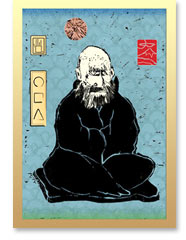On The Way: The Daily Zen Journal
Bloodstream Sermon, Part 1
Bodhidharma (440-528)
Everything that appears in the three realms leads back to the mind. Hence, buddhas of the past and future teach mind to mind without bothering about definitions.
But if they don’t define it, what do they mean by mind? You ask.
That’s your mind. I answer. That’s my mind. If I had no mind, how could I answer? If you had no mind, how could you ask?
That which asks is your mind. Through endless kalpas without beginning, whatever you do, wherever you are, that’s your real mind, that’s your real buddha.
This mind is the buddha says the same thing. Beyond this mind you’ll never find another buddha. To search for enlightenment or nirvana beyond this mind is impossible.
The reality of your own self-nature, the absence of cause and effect, is what’s meant by mind. Your mind is nirvana. You might think you can find a buddha or enlightenment somewhere beyond the mind, but such a place doesn’t exist.
Trying to find a buddha or enlightenment is like trying to grab space. Space has a name but no form. It’s not something you can pick up or put down. And you certainly can’t grab it. Beyond this mind you’ll never see a buddha. The buddha is a product of your mind. Why look for a buddha beyond this mind?
Buddhas of the past and future only talk about this mind. The mind is the buddha. And the buddha is the mind. Beyond the mind there’s no buddha. And beyond the buddha there’s no mind.
If you think there’s a buddha beyond the mind, where is he? There’s no buddha beyond the mind, so why envision one? You can’t know your real mind as long as you deceive yourself. As long as you’re enthralled by a lifeless form, you’re not free.
If you don’t believe me, deceiving yourself doesn’t help. It’s not the Buddha’s fault. People, though, are deluded. They’re unaware that their own mind is the buddha. Otherwise, they wouldn’t look for a buddha outside the mind.
To find a buddha, you have to see your nature. Whoever sees his or her nature is a buddha. If you don’t see your nature, invoking buddhas, reciting sutras, making offerings and keeping precepts are all useless.
Invoking buddhas results in good karma. Reciting sutras results in good memory. Keeping precepts results in a good rebirth. And making offerings results in future blessings. But no buddha.
Long ago, the monk Good Star was able to recite the entire Canon. But he didn’t escape the Wheel, because he didn’t see his nature. If this was the case for Good Star, then people nowadays who recite a few sutras or shastras and think it’s the Dharma are fools. Unless you see your mind, reciting so much prose is useless.
To find a buddha, all you have to do is see your nature. Your nature is the buddha. And the buddha is the person who’s free, free of plans, free of cares. If you don’t see your nature and run around all day looking somewhere else, you’ll never find a buddha. The truth is there’s nothing to find.
Bodhidharma (440-528)
Excerpted from The Zen Teaching of Bodhidharma translated by Red Pine (1987)
Unknown to all but a few disciples during his lifetime, Bodhidharma (440-528) is the patriarch of millions of Zen Buddhists and students of kung-fu. He’s also the subject of many legends.
Along with zen and kung-fu, Bodhidharma, we are told, also brought tea to China. To keep him from falling asleep while meditating, he cut off his eyelids, and where they fell, tea bushes grew.
Since then, tea has become the beverage of not only monks, but everyone in the Orient. Faithful to this tradition, artists invariably depict Bodhidharma with bulging, lidless eyes.




Bodhidharma cuts through technique and artifice to return us to the heart of training. However, just reading “the mind is buddha” does not confer that realization. We are in times of rapid change in a culture of shallow values where nodding one’s head equals understanding. Few spend the time to explore the depths of a phrase like “the mind is buddha.”
Your job is to use yourself in a way so that the mind stops taking form. A big part of your training, what they have called tugging the ox, is to inhibit the mind from taking form so much, so that your mind is formless.
We have to trust in that perfect unadorned perception. The very mind that wants to control things is the mind that’s caught up to begin with. When you’re caught up, you have less possibilities. Do you understand what I mean by letting your mind take form?
By hardening itself to a shape, a feeling, an intensity, a technique, rather than allowing that clear mirror-like perception. If you let your mind take form, it becomes localized and interferes with spaciousness. As soon as you catch yourself and return, you come back to the formless state.
This is truly an awesome undertaking. How many will continue with their practice through this lifetime… and beyond? It is the rarest of opportunities to meet with this teaching and to find a true way to explore.
Something hidden, go and find it…
Continuing along the Way,
Elana, Scribe for Daily Zen